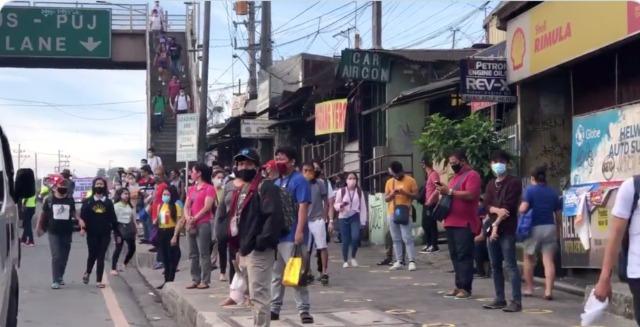42% of workers find traveling to work “very much harder"; 44% walk to work —SWS

Forty-two percent of non-home based Filipino workers found it hard to travel to work amid the COVID-19 pandemic with 44% of the respondents opted walking from their homes to their workplaces, a latest Social Weather Survey (SWS) report said.
The non-commissioned survey released on May 7 showed that 82% of the 1,500 working respondents are reporting to their workplaces and only 18% are home-based.
Of the non-home based workers, 42% said it is “very much harder” to travel to work compared to the pre-COVID-19 pandemic times; 19% find it “somewhat much harder”; and 11% said it is “slightly harder” now.
Twenty-eight percent of the respondents said traveling to work is just the same as before.
It was also found that 44% of the non-home-based workers walk to their workplaces after the respondents were asked about their means of transportation amid the COVID-19 pandemic.
Other means of transportation that were used by the workers are motorcycles (24%), tricycles (14%), jeepneys or multi-cabs (8%), bicycles (5%), buses (3%), private cars (3%), and motorboats or bangka (1%).
The survey was conducted from 21 to 24 of November 2020 where the lockdown classification was relaxed either to general community quarantine (GCQ) or modified (MGCQ).
The respondents were composed of 600 workers in Balance Luzon and 300 each in Metro Manila, Visayas, and Mindanao.
In the same survey, it was concluded that those who considered going to work to be “very much harder” compared to pre-pandemic was highest in Mindanao (60%), Visayas (48%), Metro Manila (36%), and Balance Luzon (27%).
Reporting to work is more difficult for workers who are less educated as the survey showed that the “very much harder” response was higher among non-elementary graduates (57%), than among elementary graduates (42%), junior high school graduates (38%), and college graduates (42%).
Home-based workers are highest in Metro Manila with 29%, followed by Balance Luzon with 22%, Mindanao with 13%, and Visayas with 10%.
The sampling error margins for the said survey are ±2.5% for national percentages, ±4% for Balance Luzon, and ±6% for Metro Manila, the Visayas, and Mindanao.
The SWS said the area estimates were weighted by the Philippine Statistics Authority medium-population projections for 2020 to obtain the national estimates.—AOL, GMA News



